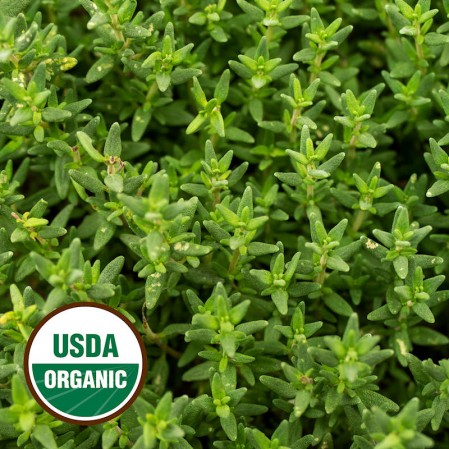Organic English Thyme Seeds
- HOW TO GROW
- FAST FACTS
- REVIEWS
HOW TO GROW
Sowing: Start thyme indoors 5-6 weeks before the last frost, sowing them 1/4" deep in a flat. Keep them out of direct sunlight, but make sure the soil temperature is at least 70 degrees F. Germination may take up to 28 days. Well after the last frost, transplant the seedlings in sandy soil and full sun. Direct sowing is possible but not recommended, since the seeds take much longer to germinate in the cool soil of spring; this significantly shortens the growing season and delays the harvest of fresh leaves.
Growing: Make sure the seedlings have adequate moisture, but as soon as they are established do not water them. Thyme thrives on neglect, preferring dry soil with no fertilization. If the soil becomes too wet, the plant may suffer from root rot or other fungal diseases. Control weeds to prevent them from competing with the slow developing thyme. Mulch may help to keep the leaves clean and discourage weeds. After the second spring of the plants' growth, prune the plants down to half their height to encourage tender stems and neat growth. Thyme grows well as a container plant, and can be propogated from cuttings or root division. As a companion plant, thyme attracts bees and discourages harmful insects such as the cabbage butterfly.
Harvesting: Harvest fresh leaves as soon as they reach a desirable size, cutting them down to 1-2" above ground level. The best time to harvest is in the morning after the dew has dried. The leaves reach their peak in flavor right before the flowers open; after this point the flavor decreases. To dry entire sprigs, bundle them and hang them upside down in a warm place out of direct sunlight. After they have dried, rub them lightly to separate the leaves from the stems. Store the leaves in an airtight container.
Seed Saving: Harvest individual seed heads as they mature and begin to dry. Spread them out to dry out of direct sunlight, then thresh them to remove the seed. Store the seed in a cool, dry place.
FAST FACTS
Common Names: German Thyme, Garden Thyme
Latin Name: Thymus vulgaris
Species Origin: Mediterranean, Southern Europe
Type: Open Pollinated, Heirloom, Warm Season
Life Cycle: Perennial
USDA Zones: 5, 6, 7, 8, 9, 10, 11, 12
Seeds per Ounce: 100,000
Planting Method: From Transplant
Sunlight: Full Sun
Height: 8 Inches
Color: Green
Bloom Season: Blooms Early Summer, Blooms Late Summer
Uses: Attracts Honeybees, Attracts Butterflies, Aromatic, Deer Resistant
ZERO (0%) Percent Germination
This is my 1st time buying from you and will be my last! I have never purchased seeds anywhere in the world where not even a single seed germinated! This was absolutely my worst experience ever!
DESCRIPTION
HOW TO GROW
Sowing: Start thyme indoors 5-6 weeks before the last frost, sowing them 1/4" deep in a flat. Keep them out of direct sunlight, but make sure the soil temperature is at least 70 degrees F. Germination may take up to 28 days. Well after the last frost, transplant the seedlings in sandy soil and full sun. Direct sowing is possible but not recommended, since the seeds take much longer to germinate in the cool soil of spring; this significantly shortens the growing season and delays the harvest of fresh leaves.
Growing: Make sure the seedlings have adequate moisture, but as soon as they are established do not water them. Thyme thrives on neglect, preferring dry soil with no fertilization. If the soil becomes too wet, the plant may suffer from root rot or other fungal diseases. Control weeds to prevent them from competing with the slow developing thyme. Mulch may help to keep the leaves clean and discourage weeds. After the second spring of the plants' growth, prune the plants down to half their height to encourage tender stems and neat growth. Thyme grows well as a container plant, and can be propogated from cuttings or root division. As a companion plant, thyme attracts bees and discourages harmful insects such as the cabbage butterfly.
Harvesting: Harvest fresh leaves as soon as they reach a desirable size, cutting them down to 1-2" above ground level. The best time to harvest is in the morning after the dew has dried. The leaves reach their peak in flavor right before the flowers open; after this point the flavor decreases. To dry entire sprigs, bundle them and hang them upside down in a warm place out of direct sunlight. After they have dried, rub them lightly to separate the leaves from the stems. Store the leaves in an airtight container.
Seed Saving: Harvest individual seed heads as they mature and begin to dry. Spread them out to dry out of direct sunlight, then thresh them to remove the seed. Store the seed in a cool, dry place.
FAST FACTS
Common Names: German Thyme, Garden Thyme
Latin Name: Thymus vulgaris
Species Origin: Mediterranean, Southern Europe
Type: Open Pollinated, Heirloom, Warm Season
Life Cycle: Perennial
USDA Zones: 5, 6, 7, 8, 9, 10, 11, 12
Seeds per Ounce: 100,000
Planting Method: From Transplant
Sunlight: Full Sun
Height: 8 Inches
Color: Green
Bloom Season: Blooms Early Summer, Blooms Late Summer
Uses: Attracts Honeybees, Attracts Butterflies, Aromatic, Deer Resistant
Reviews
Review
ZERO (0%) Percent Germination
This is my 1st time buying from you and will be my last! I have never purchased seeds anywhere in the world where not even a single seed germinated! This was absolutely my worst experience ever!






